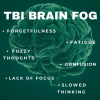Sequencing is the process of arranging thoughts, information, language, and actions in a correct or effective order. It allows us to perform our everyday routines in a more organized and efficient pattern. It is the foundation for higher order cognitive skills that relate to language and goal-directed planning. Sequencing involves other executive functioning skills, such as planning and organizing. It also involves motor planning, which is the ability to organize and carry out our body’s movements in order to perform a certain task. Examples of everyday tasks that require sequencing are:
- Driving a car
- Brushing your teeth
- Putting on clothes
- Cooking dinner
Individuals with sequencing deficits may experience:
- Difficulty following verbal or written instructions
- Difficulty completing multi-step tasks
- Difficulty with reading, writing, spelling, and math
- Difficulty learning new motor tasks
- Language problems, i.e., speaking words out of order
- Impaired working memory
- Clumsiness or uncoordinated movements
General strategies that individuals with sequencing deficits can utilize are:
- Using a checklist
- Using a visual / picture schedule
- Breaking down a task and tackling one step at a time
References:
https://childdevelopment.com.au/areas-of-concern/organisation/planning-and-sequencing-praxis/
For more TBI Glossary Terms Click Here.
NeuroPraxis is a Brain Injury Rehab Program for the Home and Community for Los Angeles, San Diego, Los Angeles, Orange County, Bakersfield, San Bernardino, Santa Barbara, Riverside, San Luis Obispo, Tulare, and Ventura.



